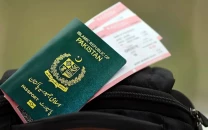Intricate designs: Ottoman embroidery, fabrics share traits with Pakistani ones
Archaeologist Alper Yurdeni showed his personal collection of imperial Turkish designs.

The lecture was held at the Indus Valley School of Art and Architecture (IVS) on Wednesday. Archaeologist and Ottoman embroidery collector Alper Yurdeni showcased his personal collection of imperial Ottoman designs and compared them to the contemporary trends in pop culture to describe how the designs have evolved over time.
According to Yurdeni, he was only five when he ventured into collecting samples of imperial Ottoman embroideries. "It was not until I graduated from university that I opened my own shop of embroidery collection, which is the largest in Ankara."
The archaeologist's collection extended to 17 different categories encompassing all forms of apparel and accessories wear. From the formal bridal veil and bath towels to a barber's apron, the Ottoman inspiration resonated everywhere.

Talking about the designers of the 18th and 19th centuries, Yurdeni explained that most drew their inspirations from ornamentation in palaces. He exhibited embroidery samples comprising flora, animal figures, fruits, fishes, vases and ships: all of them providing a rich and thoughtful symbolism.
For instance, in Greek-inspired Ottoman creations, flowers like lotus and rose signified love and happiness. Similarly, embroidered peacocks were exchanged as gifts as they symbolised longevity and good luck.
One of the most distinctive aspects of the entire collection was the Ark of Noah. This was because of the bold floral patterns that the ship adorned and the architectural representation of the sailing vessel itself.
Apart from the use of gold and silver threads, there were a few other aspects which showed similarity between the traditional Ottoman and Pakistani embroidery techniques. 'Salma' and 'dabka' were the two most striking examples of Ottoman resemblance hitting home.
Replying to a question about the longevity of Turkish embroidery designs, Yurdeni said that they are not a living tradition. People like to pass on rare designs to their children but they are only kept as souvenirs.
"Classic, imperial designs are still practised but their market presence is not so promising in Turkey," said Yurdeni.
Talking about the base fabric of the Ottoman embroidery, Yurdeni shared that they were quite similar to the ones used in Pakistan. Silk and wool were in rampant use, especially in accessories like Saleem Shahi shoes and bridal coats.
Yurdeni's collection was inspired by and combined with traditional designs from Egypt, Israel, Greece, Syria and Armenia. They made great use of red and green colours in contrasting hues. Interestingly, the colours did not follow the code of nature. The trees were not green and the skies were not blue.
"These pieces represent emotions like joy and sorrow of the families [who designed the embroidered masterpieces]," said Yurdeni, pointing towards the trees woven in white thread.
Published in The Express Tribune, November 14th, 2014.



















COMMENTS
Comments are moderated and generally will be posted if they are on-topic and not abusive.
For more information, please see our Comments FAQ